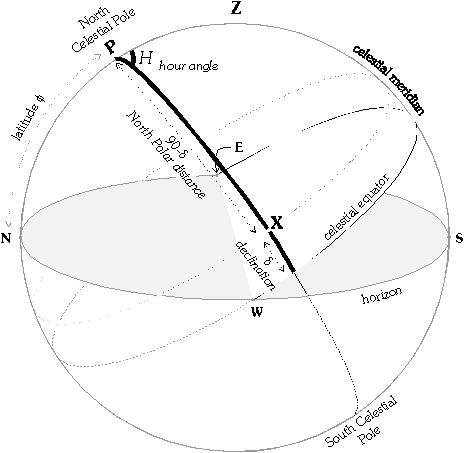
The horizontal or alt-az system depends on place (because the sky appears different from different points on Earth) and on time (because the Earth rotates, and each star appears to trace out a circle centred on North Celestial Pole).
Stars close to North Celestial Pole never set; if a star's north polar distance is less than the altitude of the Pole, then that star cannot reach horizon. These are defined as north circumpolar stars. Similarly, stars close to the South Celestial Pole will never rise - south circumpolar stars. All others are equatorial stars, which rise and set. This division of sky is dictated by the altitude of the North Celestial Pole, i.e. by the observer's latitude.
We need a system of celestial coordinates which is fixed on the sky, independent of the observer's time and place. For this, we change the fundamental circle to the celestial equator.
The North Celestial Pole and the South Celestial Pole lie directly above North and South Poles of Earth. The NCP and SCP form the poles of a great circle on celestial sphere, analogous to the equator on Earth. It is called the celestial equator and it lies directly above the Earth's equator.
Any great circle between the NCP and the SCP is a meridian. The one which also passes through the zenith and the nadir is "the" celestial meridian, or the observer's meridian. (It is identical to the principal vertical.) This provides our new zero-point; in this case, we use the point where it crosses the southern half of the equator.

A typical star comes up over the horizon (rises) somewhere
in the eastern sector;
it moves round to the right, climbing higher in the sky;
it reaches its highest point when it's due south, i.e. on the meridian;
it continues moving right, and sinking lower;
and it disappears below the horizon (sets) somewhere in the western sector.
Its highest point, due south, is called (upper) transit or culmination.
The object will also cross the meridian again, in the opposite direction,
at the lowest point in its daily path. This is called lower transit,
and it occurs below the horizon unless the star is circumpolar.
To fix the coordinates of an object X on the celestial sphere, draw the meridian through X. The declination of X is the angular distance from the celestial equator to X, measured from -90° at the SCP to +90° at the NCP. Any point on celestial equator has declination 0°. Alternatively, the North Polar Distance of X = 90° - declination. Any two objects with the same declination lie on a parallel of declination.
The Hour Angle or HA of object X is the angular
distance between the meridian of X and "the" celestial meridian.
It is measured westwards in hours, 0h-24h, since the Earth rotates
360° in 24 hours.
1 hour = 15°
1 minute = 15'
1 second = 15"
An object on the meridian (culminating) has HA = 0h. Its HA then steadily
increases as the object moves westwards. At lower transit, when it is due
north (and possibly below the horizon), its HA = 12h. At HA = 23h, it is
just one hour short of culminating again.
This system is still tied to the observer's here-and-now, but an object's declination doesn't change rapidly, and its Hour Angle can be determined quite simply, given the time and the location. A telescope can be built on an equatorial mounting, with its axis pointing at the NCP. Once set on a star, if the telescope rotates about its polar axis at the correct speed (15° per hour), the star will stay in view.

Return to index.